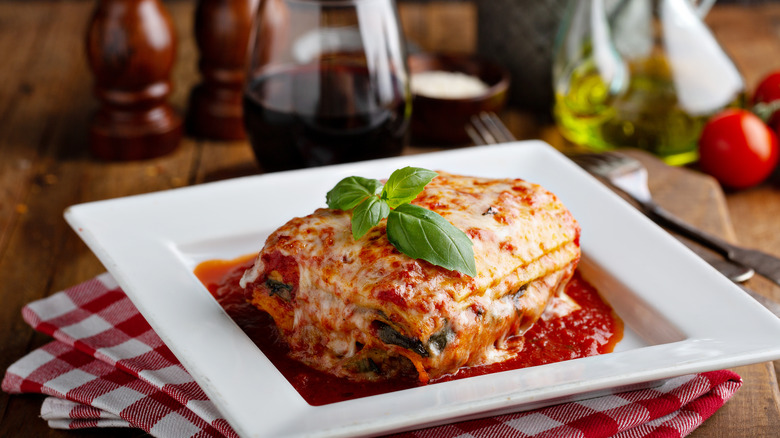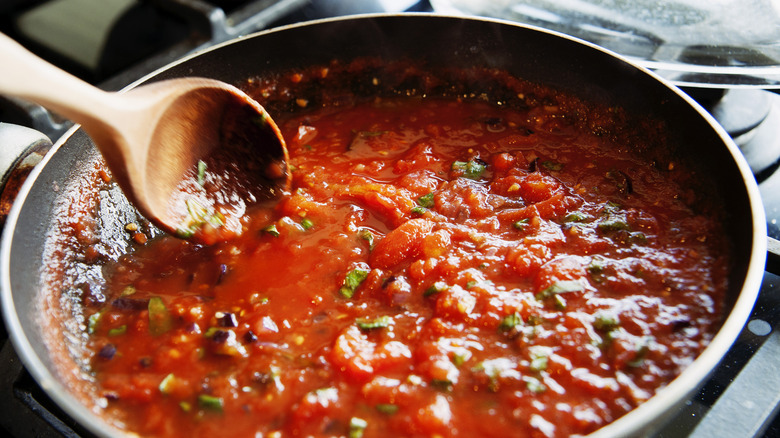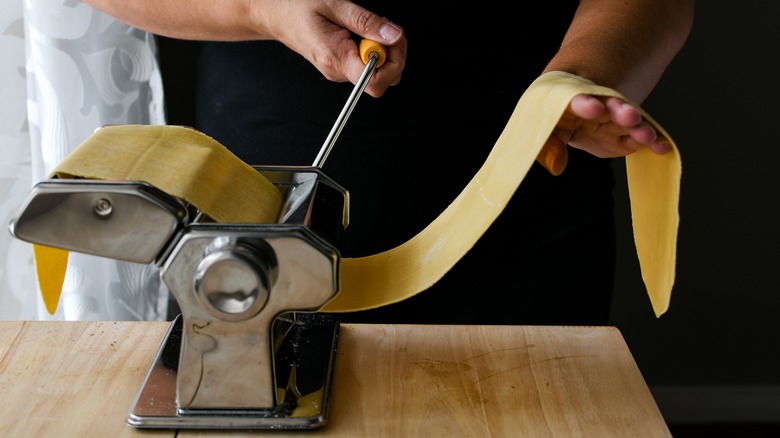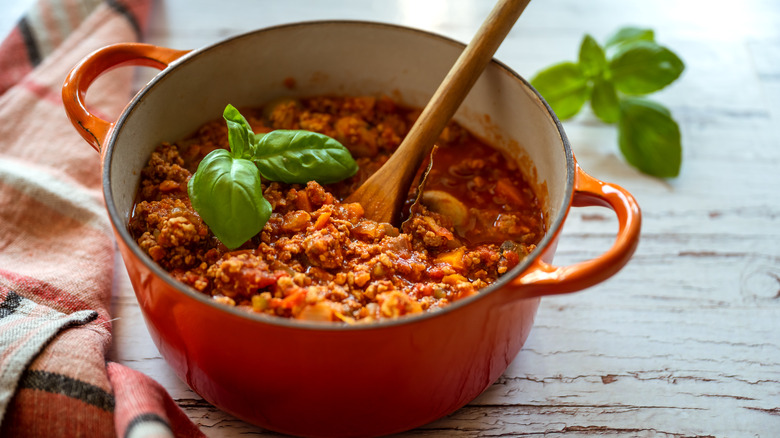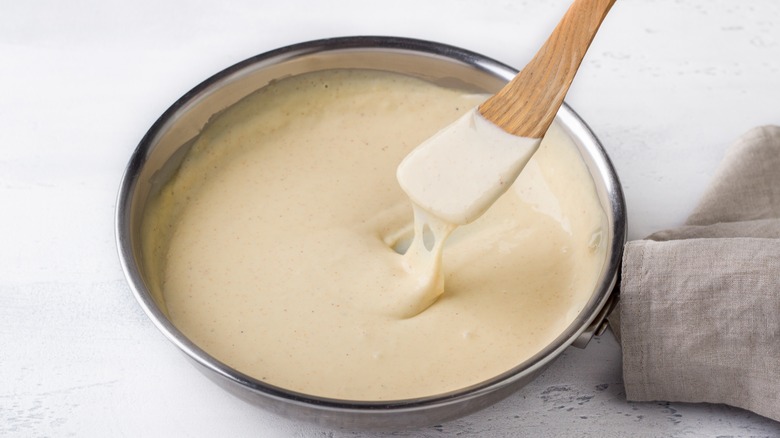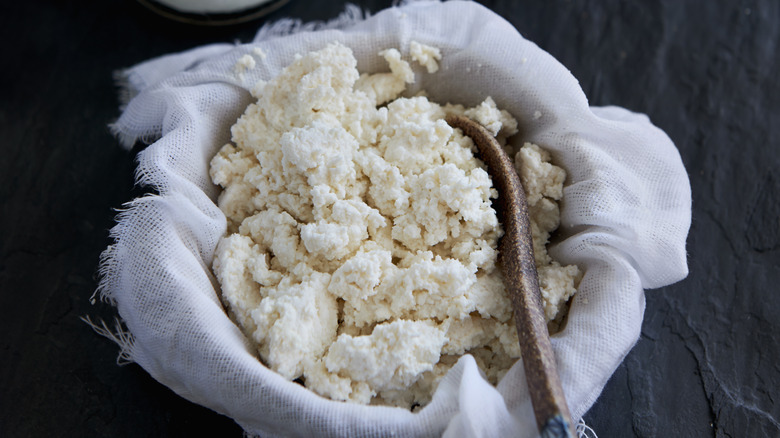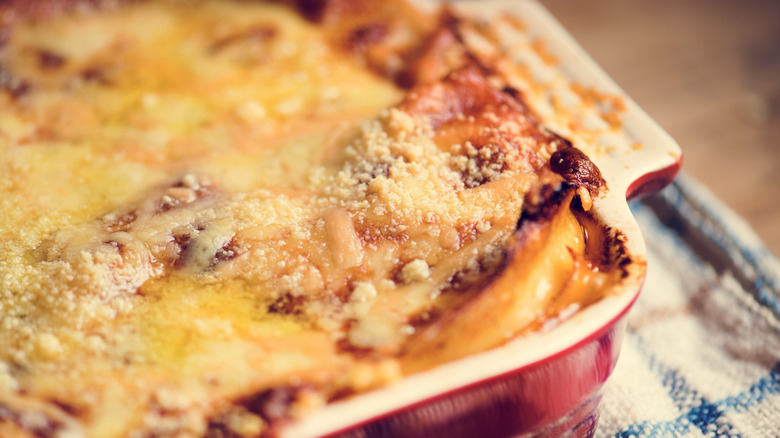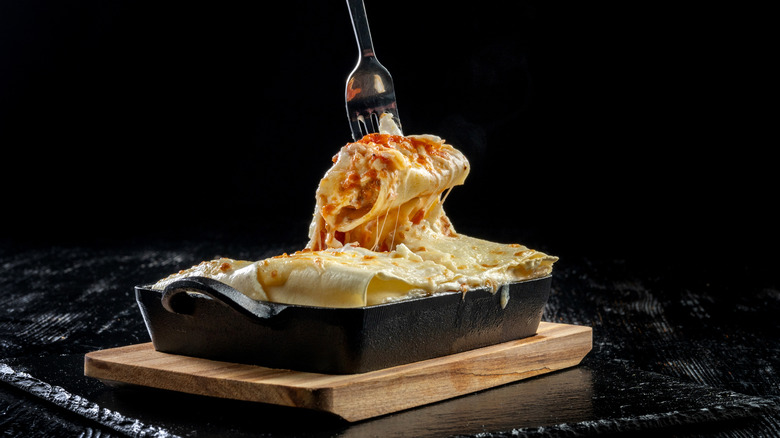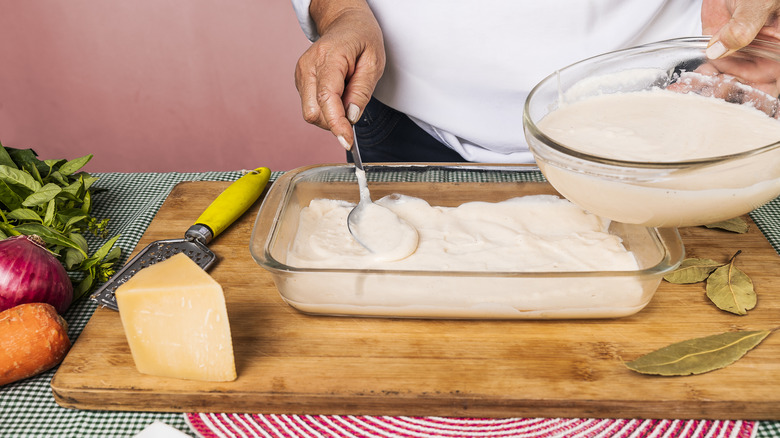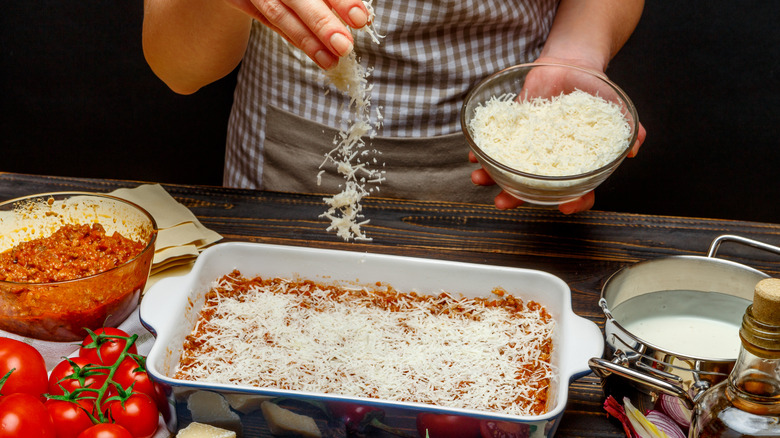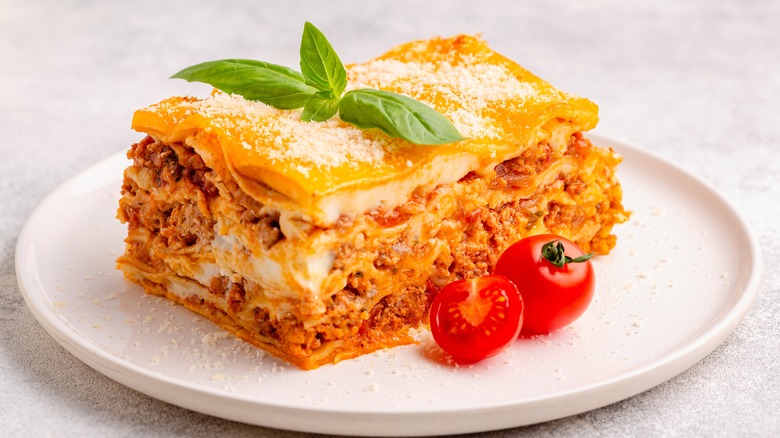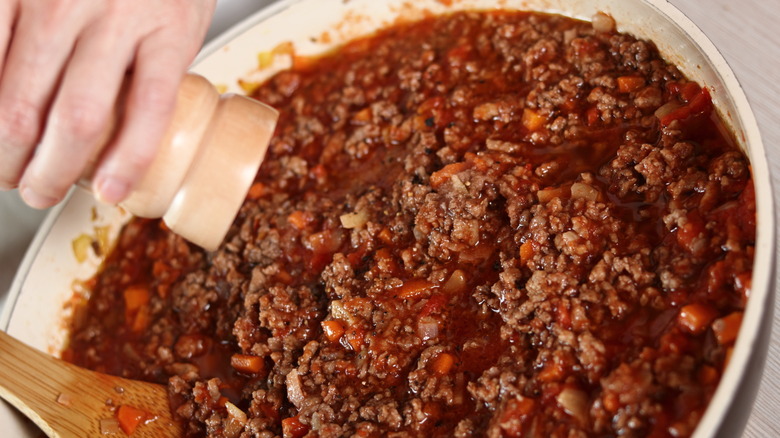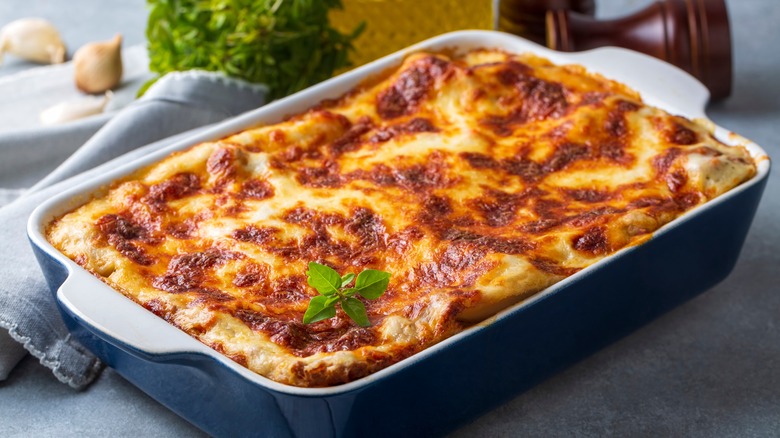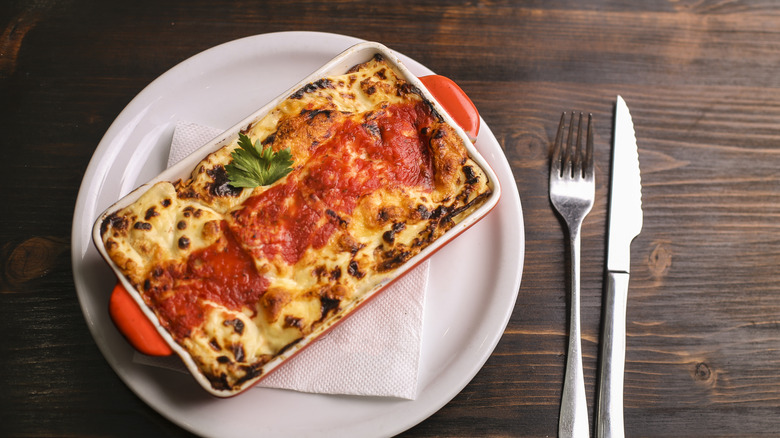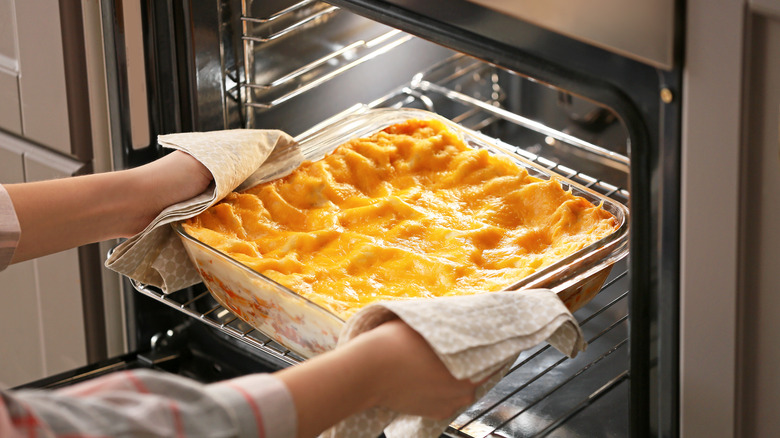Why Lasagna Always Tastes Better At A Restaurant Than At Home
Lasagna is always a crowd-pleaser, whether it's made at home or served at a restaurant. But why is it that lasagna at a restaurant always seems to taste better than homemade versions? It's all in the preparation. When it comes to lasagna, chefs have a few tricks up their sleeves that help take this cheesy baked pasta dish to the next level. From using top-notch ingredients to strategic seasoning and layering techniques, their methods ensure their lasagna hits the mark every time.
One of the great things about lasagna is how versatile it is. There are so many ways you can prepare it, from classic bolognese to variations with different meats like turkey, veal, or sausage. If you want to go veggie, you can swap in lentils for a meatless lasagna or opt for a comforting and classic spinach and ricotta lasagna. White lasagna features a creamy white sauce instead of tomato sauce. However, no matter what version you're going for, it has to be cooked right. If you want to elevate your homemade lasagna to restaurant quality, it helps to know what chefs do differently than home cooks. These are just a few reasons why the lasagna you order at a restaurant may taste better than at home.
Chefs make their pasta sauce from scratch
Sauce is one of the most important elements of lasagna because it adds moisture and gives the dish its rich flavor. The reason pasta sauce tastes so much better at certain restaurants is that any restaurant worth its salt makes its sauce in-house. A good chef will start with fresh ingredients and build an aromatic base with ingredients like vegetables, herbs, and spices. They'll make sure the seasoning is just right to make the flavors pop.
If you have the time and inclination to make homemade sauce, it's worth the effort. However, if you're in a crunch and need to resort to pre-made sauce, try to use a top-quality brand. Look for sauces that contain more real ingredients than fillers and ones that go easy on preservatives and sugar. A few pasta sauces that even celebrity chefs love to use include Rao's, Mutti's, and Bio Orto. If you're feeling fancy, you can jazz up your store-bought sauce with dried herbs, butter, or a splash of wine. You can also try Giada De Laurentiis' secret ingredient and throw a few parmesan rinds into the sauce.
Chefs use fresh pasta noodles
The noodles add texture and structure to lasagna, so they're a pretty key component of the dish. Artisan pasta maker Silvana Lanzetta of The Pasta Artist says, "The golden rule for a good lasagna is to use good fresh egg pasta. The secret to a truly authentic and delicious lasagna lies in making the pasta sheets by hand." Many restaurants abide by this rule, making fresh pasta in-house. This is just one reason why your order of lasagna may have that perfect tenderness that's not too mushy or too tough. The fresh, eggy noodles also give the lasagna a burst of flavor.
Obviously, making fresh pasta takes time and perhaps even some trial and error to get right. If you want to make it easy on yourself, store-bought noodles are fine. Be aware though that there is one lasagna shortcut that pro chefs won't touch — no-boil noodles. According to kitchen experts on HuffPost, oven-ready noodles just don't provide enough starch or firmness. To cook dried noodles, boil them in salted water as per the instructions until just al dente. Remember that the noodles will keep cooking in the oven, so you don't want them to be too soft.
Chefs know not to make the sauce too watery
There's nothing sadder than a soggy lasagna. If your lasagna comes out a slippery, wet mess, the main culprit could be a watery sauce. Ideally your sauce should be thick enough to spread instead of pour. As chef Tina Prestia of Tina's Table says, "Keep in mind that the sauce shouldn't be too loose. Reduce it enough so that it's not soupy or it could keep your lasagna from holding its shape."
Most restaurants wouldn't dream of sending out an order of lasagna that's swimming in a watery sauce. To get around this, chefs have a few tricks they use to ensure the sauce isn't too thin. Rachael Ray suggests adding more meat to your bolognese sauce or more tomato paste if you're going for a vegetarian tomato sauce. Cornstarch is another thickening ingredient that can prevent soupy lasagna. Be sure to drain off any excess fat from meat before adding it to your sauce, as the grease can add to the liquid content. If your sauce is still too runny after all of that, simply keep it simmering until it reduces to the right consistency.
Some chefs use bechamel sauce instead of ricotta
While home cooks may use ricotta to give their lasagna that extra creaminess, many chefs swear by béchamel. The team from the Martha Stewart Test Kitchen said, "Using ricotta is easier than making a béchamel sauce, but like legions of other cooks, we think béchamel produces a more delicious lasagna. The rich, creamy sauce balances the acidity from the tomatoes and is better at keeping the layers of pasta together than ricotta."
Béchamel is not particularly difficult to make. The classic recipe contains just three ingredients: flour, butter, and milk. To make this French mother sauce, you start by warming some milk in a saucepan. Then melt the butter in a pan and add flour to create a light-colored roux. Add the warm milk and whisk until the sauce is smooth and creamy. Béchamel is typically seasoned with salt, pepper, and a pinch of nutmeg. If you're using bolognese sauce and béchamel in your lasagna, you may want to go easy on your layers to ensure the lasagna doesn't get too soggy.
Chefs who use ricotta strain it before adding it to the lasagna
If your favorite restaurant lasagna contains ricotta, you may be wondering why it's so light and fluffy compared to the version of lasagna you make at home. The secret is to strain the ricotta before adding it to the lasagna. Ricotta is a soft, mild cheese that typically contains a lot of liquid. If you don't strain it beforehand, it can be yet another element that makes your lasagna soggy.
One of the easiest ways to strain ricotta is to line a strainer or colander with cheesecloth and set it over a bowl. Some people recommend folding the cheesecloth over the top of the ricotta and putting a heavy object on top to help force more of the liquid out. There's no hard and fast rule to how long you need to strain it, but the longer you do, the less watery it will be. The Snappy Gourmet recommends letting it sit for at least four hours, or better yet, overnight. Some chefs also season their ricotta to add extra flavor to the mild cheese. For example, the Auguste Escoffier School of Culinary Arts suggests adding salt, lemon juice, egg, and parsley.
Chefs often use a mix of cheeses
Cheese is the luscious, creamy glue that holds a lasagna together. Many home cooks go for the standard mozzarella, parmesan, and ricotta. However, chefs aren't afraid to mix it up when it comes to the cheeses. Ina Garten adds a touch of tang to her Roasted Vegetable Lasagna with goat cheese. Emeril Lagasse adds buttery provolone to his Slow-Cooked Lasagna. The secret ingredient for Ree Drummond's creamy lasagna is cottage cheese.
If you're thinking about experimenting with cheese, there are some cheeses that work well in lasagna and others that you may want to leave out. For example, hard Italian cheeses like Pecorino Romano and Parmigiano Reggiano complement the flavors of the tomatoes and bolognese sauce and add a touch of umami to the dish. Gouda melts beautifully and can add a slight nutty flavor. Some people advise against using pungent cheeses like cheddar and blue cheese because they can overpower the other ingredients in the lasagna. However, it's all a matter of taste. There's nothing stopping you from trying different flavor combos.
Some chefs cook their lasagna in cast iron pans instead of glass baking dishes
Glass baking dishes certainly have their appeal for lasagna. They're sturdy enough to hold the heavy ingredients of the lasagna and look great when placed on the table, as you can see all of the beautiful layers on display. However, some chefs swear by cast-iron pans. In an Instagram post about her supreme lasagna, Martha Stewart explained that ceramic or enameled cast-iron pans are best because they hold heat better than glass ones, so they cook the lasagna more evenly and help create those delicious crispy edges.
Some chefs also believe size matters when it comes to lasagna pans. According to Michael Symon, the best pan size for lasagna is 9x13 inches. The chef told Food & Wine that size is best because, "It keeps the ingredients condensed so the final product is nice and thick, versus each layer being spread thinly in a larger pan." According to Saveur, another reason a 9x13-inch pan is ideal for lasagna is that you can fit three regular lasagna noodles in the pan without having them overlap.
Restaurant lasagna starts with a layer of sauce
If you've ever wondered how restaurants always seem to plate their lasagna so perfectly, one reason could be the layering technique. Many chefs recommend starting with a layer of sauce. It may seem counterintuitive to put a layer of liquid down first, but the sauce stops the lasagna noodles from sticking to the bottom of the pan. That makes it easier to slice the lasagna and get it out of the pan without mangling it.
While the exact layering formula may vary depending on your ingredients, most chefs agree that the first two steps should be sauce, then noodles. After that, you can add your ricotta and sauce (or vice versa) topped with a layer of cheese. Repeat until you run out of noodles. The final layer should be sauce and then grated cheese. It's crucial to have cheese as the final layer on the top of the lasagna because that's what will help you achieve that lovely golden crust.
Chefs spread their ingredients evenly
Think of the best lasagna you ever ate. We're willing to bet that each bite gave you an array of flavors and textures working beautifully with one another. One way that chefs achieve this is by ensuring each layer is spread evenly in the pan. Whether it's meat, béchamel, vegetables, or cheese, you want to make sure that the layers are spread to the edges of the dish or pan and that the ratio between each layer is balanced. Otherwise, you could end up with a lasagna that doesn't mesh well on the plate or in your mouth.
One of the common mistakes that people make with lasagna is overloading the layers. You may be tempted to amp up the meat sauce for a heartier dish or pile on the cheese to enhance the gooiness factor, but the end result will likely be a sloppy lasagna. Another mistake that people make is not cutting their vegetables uniformly. You want to make sure your veggies are diced or sliced thinly so that they're easy to bite into. Overall, you want each bite of your lasagna to be balanced and not overwhelmed by one particular ingredient.
Chefs aren't stingy with the layers
While chefs may be careful not to overload their ingredients, that doesn't mean they're skimping on the layers. After all, lasagna is meant to be a hearty, indulgent dish. Many restaurants go for the "wow factor" and stack their lasagnas high. For example, L'Ardente in Washington, D.C. famously serves a 40-layer lasagna layered with paper-thin pasta, short rib sugo, truffle mornay, and sottocenere cheese. New York restaurant Del Posto served an impressive 100-layer lasagna prior to its closing in 2021.
For home cooks, there's no definitive answer to how many layers a lasagna should have. It depends on a number of factors, including your personal preferences, the depth of your cooking dish or pan, and how many mouths you have to feed. One Reddit user said, "Filling the pan is probably the right way to go. Just make sure you leave room for the top layer of cheese to melt." If you're planning on layering up, keep in mind that the more layers you have, the longer it will take your lasagna to cook.
Chefs season every layer of the lasagna
One of the main reasons why restaurant dishes taste so much better than what you cook at home is because chefs season their food liberally. They don't just sprinkle some salt and pepper on a dish before serving it. Most chefs season throughout the cooking process. With so many components, lasagna provides plenty of opportunities for ample seasoning. From cooking the noodles in salted water to adding a splash of wine to your bolognese or fresh herbs to your ricotta, there are so many ways to enhance the flavor of your lasagna.
Top chefs agree that seasoning is the key to a great lasagna. Giada De Laurentiis told Bon Appetit that her seasoning trick to avoid bland lasagna is to season at every step. Food bloggers Jeanine and Jack of Love and Lemons also recommend spicing it up, saying "For the most flavorful lasagna, season every layer. Instead of using plain crushed tomatoes, simmer them with seasonings like garlic, oregano, and basil to make marinara sauce (or use store-bought marinara sauce). And at a minimum, mix the ricotta with salt and fresh black pepper."
Some chefs top their lasagna with butter
Another thing restaurants don't skimp on is butter. When Anthony Bourdain was asked about butter on the Oprah Winfrey Show, he said, "It's usually the first thing and the last thing in just about every pan." The fat content in butter adds a lusciousness that just can't be beat. It also adds flavor, prevents sticking, and can help balance acidic tomato sauces. That's why some chefs recommend using butter to take lasagna to the next level.
Lasagna can be pretty rich to begin with, so the trick to adding butter is to use it sparingly. Nadia Caterina Munno of the Pasta Queen suggests greasing the baking dish with butter. This helps prevent the noodles from sticking and can help the edges crisp up. In Giada De Laurentiis' Classic Italian Lasagna recipe, she suggests adding cubes of butter to the top layer. She says, "Don't skip the dotting of the butter on top of the lasagna – it makes the entire thing so golden brown, beautiful and delicious."
Restaurant lasagna is usually rested before serving
The first thing you probably want to do when you pull your lasagna out of the oven is dig into those saucy, cheesy layers. However, that may just be why your lasagna falls flat compared to restaurant versions. Lasagna needs to rest after cooking to give the ingredients time to firm up. Silvana Lanzetta of the Pasta Artist recommends letting it rest for at least half an hour.
Resting is such a crucial step that it was one of only two lasagna tips Giada De Laurentiis gave to the royal family when she cooked for the Duke and Duchess of Cambridge at the Foundation Polo Challenge in Santa Barbara, California. According to PopSugar, when Prince William asked what the key to a great lasagna was, De Laurentiis said, "You've got to make sure that you have enough sauce to get a nice crust on top and you've got to let it sit before you cut into it. It has got to set, otherwise it'll just be a pool of mess."
Chefs often broil the lasagna before serving it for extra crunch
Is there anything more beautiful than a lasagna with a golden brown, crunchy cheesy crust? If you're having trouble achieving that crunchy top layer at home, do what many restaurants do and give your lasagna a quick broil at the end. The high heat should crisp up the top layer of cheese. The end part is key though — you don't want to broil your lasagna the entire time it's in the oven because you'll end up with a dried-out brick.
Michael Symon's trick for getting a crispy finish to the top of your lasagna is to cover it first, then broil it right at the end. He told Food & Wine, "Always cover it with foil at the beginning of the cooking process, then remove it for the last 10 minutes to let the cheese on top get brown and crispy." According to Jamie Oliver, "It's best to cover your lasagne with tin foil for the first thirty minutes and then remove the foil and bake for a further 10-20 minutes until the top is golden and crispy and the whole dish is piping hot through." This same method is the best way to reheat leftover lasagna for a deliciously crispy top. Just be sure to keep an eye on the lasagna during the broiling period to make sure it doesn't burn.

